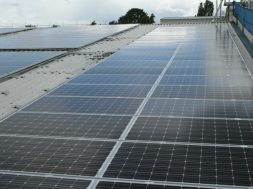
It’s the best of times and the worst of times to make solar panels.
The world’s biggest solar-module manufacturers have had a bumper year in 2016. JinkoSolar Holding Co., Trina Solar Ltd., JA Solar Holdings Co., Canadian Solar Inc. and Yingli Green Energy Holding Co. all lost money in every quarter of 2012, and in most periods of 2013. This year, all of them, along with Hanwha Q Cells Co., managed to post a profit every quarter.
At the same time, the selling prices of the modules they produce have been falling through the floor. After the industry’s last dalliance with overcapacity, in 2011 and 2012, caused prices to slump as much as 40 percent in a year, a winnowing of less efficient players allowed the market to stabilize. Costs of silicon modules even rose modestly in 2013, before continuing their decline at 10 percent or so a year.
Things changed this year as a glut of new panels hit the market. So far, the average price of modules is down about 29 percent, hitting a record low 39.6 cents per watt last month.
Trina Solar is showing signs of pulling back in response to conditions. Third-quarter shipments of 1.36 gigawatts fell below the bottom end of guidance, the company said Wednesday, while revenue and profits both slipped.
Still, the fall wasn’t drastic. Gross margin dropped to 16.9 percent, but remained within the approximate 15 percent to 20 percent band it’s occupied for 13 straight quarters — hardly a sign that the current supply flood is causing Trina Solar to take on water.
Meanwhile, the falling top-line price of modules is good news for the rollout of solar technology. Module prices are about 37 percent of the cost of utility-scale fixed solar systems in the U.S., contributing 65 cents out of an overall cost of $1.77 per watt, according to a study last year. Assuming the costs of installation, electricity inverters, tax and developers’ margins haven’t changed, the decline in module prices alone would now put that figure at around $1.52 per watt, further enhancing solar’s ability to compete with fossil fuels just on price.
Record low module price in October
39.6c/W
The big six have good reason to keep expanding output. Their production of 23.5 gigawatts of modules in 2015 was about 91 percent of their 25.8-gigawatt output capacity, suggesting demand remains strong.
They’re also showing greater market dominance, one likely contributor to Trina’s resilient margins. Output by the big six last year was equivalent to 42 percent of total installations, up from 24 percent five years earlier. While the glut of modules looks set to continue, price declines are likely to return to the more traditional pace of 10 percent or so in 2017.
President-elect Donald Trump’s views on climate change and fossil fuels are naturally seen as a problem for renewable energy, but solar and wind power these days are in many places cheaper than coal and gas. Elsewhere, they’re catching up rapidly, or are hampered mainly by the capital structure of renewables — more upfront investment is needed, despite operating costs close to zero.
Trina Solar closed on Tuesday about 11 percent below the $11.60 per share in its $1.1 billion privatization plan, on which holders will vote Dec. 16. But its steady profitability in the face of oversupply is an indicator that the solar industry has grown up since its last glut.
Gadfly has previously argued that the proposed deal sells the company short given the pace of profitable growth Trina is chalking up. Shareholders would be wise to demand more than Chairman Jifan Gao is offering.
This column does not necessarily reflect the opinion of Bloomberg LP and its owners.















